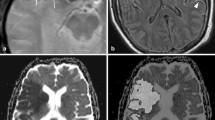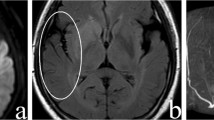Abstract
Background
To assess the influence of the hyperintense acute reperfusion marker (HARM) on the relative signal intensity (rSI) and apparent diffusion coefficient (ADC) of hyper-acute ischemic lesions in a canine stroke model.
Methods
Middle cerebral artery occlusion models were established using autologous clot embolization. Diffusion-weighted (DW) and fluid-attenuated inversion recovery (FLAIR) imaging was performed at 1, 2, 3, 4.5 and 6 h after embolization. HARM was defined as the delayed enhancement of cerebrospinal fluid on the subsequent FLAIR images after contrast media used.
Results
Twenty-four stroke models were successfully established and divided into the HARM (n = 16) and No-HARM group (n = 8). No significant differences were found in the rSI on DWI (b0 and b1000 map) and relative ADC between the two groups at each time point after embolization (all P > 0.05). There were no significant differences in the rSI on FLAIR at 1 and 2 h after embolization between the two groups (P > 0.05), while the HARM group showed significantly higher rSI on FLAIR than the No-HARM group at 3, 4.5 and 6 h after embolization (P = 0.044, 0.036 and 0.001, respectively).
Conclusions
HARM should be noted during the quantitative analysis of FLAIR images in future clinical practice.




Similar content being viewed by others
Abbreviations
- HARM:
-
Hyperintense acute reperfusion marker
- SI:
-
Signal intensity
- ADC:
-
Apparent diffusion coefficient
- MCAO:
-
Middle cerebral artery occlusion
- DWI:
-
Diffusion-weighted imaging
- FLAIR:
-
Fluid-attenuated inversion recovery
References
Madai VI, Wood CN, Galinovic I, et al. Clinical-radiological parameters improve the prediction of the thrombolysis time window by both MRI signal intensities and DWI-FLAIR mismatch. Cerebrovasc Dis. 2016;42:57–65.
Liu S, Xu X, Cheng Q, et al. Simple quantitative measurement based on DWI to objectively judge DWI-FLAIR mismatch in a canine stroke model. Diagn Interv Radiol. 2015;21:348–54.
Kim BJ, Kim HJ, Lee DH, et al. Diffusion-weighted image and fluid-attenuated inversion recovery image mismatch: unclear-onset versus clear-onset stroke. Stroke. 2014;45:450–5.
Thomalla G, Cheng B, Ebinger M, et al. DWI-FLAIR mismatch for the identification of patients with acute ischaemic stroke within 4.5 h of symptom onset (PRE-FLAIR): a multicentre observational study. Lancet Neurol. 2011;10:978–86.
Tanriverdi Z, Gocmen R, Oguz KK, et al. Elevations in tissue fluid-attenuated inversion recovery signal are related to good functional outcome after thrombolytic treatment. J Stroke Cerebrovasc Dis. 2016;25:480–3.
Xu XQ, Cheng QG, Zu QQ, et al. Comparative study of the relative signal intensity on DWI, FLAIR, and T2 images in identifying the onset time of stroke in an embolic canine model. Neurol Sci. 2014;35:1059–65.
Ostwaldt AC, Rozanski M, Schmidt WU, et al. Early time course of FLAIR signal intensity differs between acute ischemic stroke patients with and without hyperintense acute reperfusion marker. Cerebrovasc Dis. 2014;37:141–6.
Bonzano L, Roccatagliata L, Levrero F, et al. In vitro investigation of poor cerebrospinal fluid suppression on fluid-attenuated inversion recovery images in the presence of a gadolinium-based contrast agent. Magn Reson Med. 2008;60:220–3.
Köhrmann M, Struffert T, Frenzel T, et al. The hyperintense acute reperfusion marker on fluid-attenuated inversion recovery magnetic resonance imaging is caused by gadolinium in the cerebrospinal fluid. Stroke. 2012;43:259–61.
Kim EY, Kim SS, Na DG, et al. Sulcal hyperintensity on fluid-attenuated inversion recovery imaging in acute ischemic stroke patients treated with intra-arterial thrombolysis: iodinated contrast media as its possible cause and the association with hemorrhagic transformation. J Comput Assist Tomogr. 2005;29:264–9.
Madai VI, Galinovic I, Grittner U, et al. DWI intensity values predict FLAIR lesions in acute ischemic stroke. PLoS ONE. 2014;9:e92295.
Emeriau S, Soize S, Riffaud L, et al. Parenchymal FLAIR hyperintensity before thrombolysis is a prognostic factor of ischemic stroke outcome at 3 Tesla. J Neuroradiol. 2015;42:269–77.
Zu QQ, Liu S, Xu XQ, et al. An endovascular canine stroke model: middle cerebral artery occlusion with autologous clots followed by ipsilateral internal carotid artery blockade. Lab Invest. 2013;93:760–7.
Liu S, Hu WX, Zu QQ, et al. A novel embolic stroke model resembling lacunar infarction following proximal middle cerebral artery occlusion in beagle dogs. J Neurosci Methods. 2012;209:90–6.
Lee H, Kim E, Lee KM, et al. Clinical implications of sulcal enhancement on postcontrast fluid attenuated inversion recovery images in patients with acute stroke symptoms. Korean J Radiol. 2015;16:906–13.
Ostwaldt AC, Rozanski M, Schaefer T, et al. Hyperintense acute reperfusion marker is associated with higher contrast agent dosage in acute ischaemic stroke. Eur Radiol. 2015;25:3161–6.
Xu XQ, Zu QQ, Lu SS, et al. Use of FLAIR imaging to identify onset time of cerebral ischemia in a canine model. AJNR Am J Neuroradiol. 2014;35:311–6.
Author information
Authors and Affiliations
Corresponding authors
Ethics declarations
Funding information
This research is founded by National Natural Science Foundation of China (81401497 to XQ Xu; 81571777 to HB Shi; 81471764 to S Liu; 81501565 to QQ Zu; 81401383 to SS Lu).
Conflict of interest
The authors declared no conflicts of interest.
Additional information
X.-Q. Xu, C.-J. Wu and Q.-Q. Zu contributed equally to this work.
About this article
Cite this article
Xu, XQ., Wu, CJ., Zu, QQ. et al. Temporal evolution of the signal intensity of hyper-acute ischemic lesions in a canine stroke model: influence of hyperintense acute reperfusion marker. Jpn J Radiol 35, 161–167 (2017). https://doi.org/10.1007/s11604-017-0615-1
Received:
Accepted:
Published:
Issue Date:
DOI: https://doi.org/10.1007/s11604-017-0615-1




